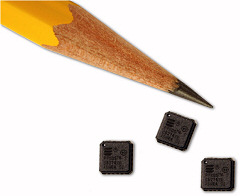Manufacturers today struggle with cost, assembly, and reliability issues that reduce profit margins, cause field failures, and erode customer confidence. Many of these issues stem from the use of complex wiring harnesses or simplistic bus technologies such as RS-485. Most control networking technologies were not designed for low-cost sensors and hence are either too expensive or do not fit the desired features to network them. For example, a manufacturer cannot add extra networking functionality with an $8 price tag to a low-end sensor costing $10–$15. Neither can the same sensor rely on the more complex and expensive network commissioning tools and systems integrators. Sensors have typically been connected to the controller via a wiring harness, as individual analog I/O. Current control networking technologies connect various controllers on the factory floor. In contrast, embedded control networks seek to replace the analog connections between controller and sensors either within a machine or in a small area (Figure 1).
 Figure 1. The need for embedded control networks |
Desired Features of Embedded Control Networks
Key characteristics of embedded control networks include:
- Self-Organizing—configure themselves into a fully functional state; plug-and-play
- Link Powered—supply a limited but sufficient amount of current to power small sensors and actuators on the same wires used for control communication
- Flexible Wiring—let the wiring fit the most logical layout of the machine allowing a star, bus, ring, or mixed wiring configuration
- Reliable Communication—factory floors have harsh environmental conditions that make reliable communications difficult. If using RF-based systems, you should ask questions about how the systems are affected by reflections from moving equipment and people, null zones, and battery life
- Low-Cost
- Connectivity with External Networks and Internet—enables remote monitoring and control
Benefits of Embedded Control Networks
These features of embedded control networks translate into a number of benefits, including more efficient operations and reduced product, installation, warranty, and life-cycle costs.
- Minimized Lifetime Product Cost—A self-organizing network eliminates the need to hire skilled labor or technicians to install devices in the field and reduces assembly and maintenance costs. Improved reliability results in fewer failures and lower warranty costs.
- New Functionalities Enabled—By providing local and remote access to low-level data from sensors and actuators, you can extract process efficiency and energy consumption information, enabling new analyses and features that were previously impossible.
- Higher Customer Satisfaction—The more detailed information available from sensors enables preventive and predictive maintenance using remote or local diagnostics of the machines. This reduces machine downtime and increases customer satisfaction.
- Secure Customer Business—Sensors with embedded control networking can transmit data about preemptive maintenance directly to manufacturers, allowing them to approach customers in a timely manner and retain their business.
Designed from the Ground Up
The Pyxos platform provides an enduring, widely adoptable platform for embedded control networking. The free topology twisted-pair network for Pyxos has a master-slave architecture consisting of as many as 32 point nodes embedded inside sensors and actuators, and a pilot (controller) node that interfaces with the outside world through LonWorks networks (Figure 2). The network operates at 312.5 Kbps using a deterministic signaling method by which all 32 point nodes are scanned every 25 ms (proportionally faster with fewer points in the system).
 Figure 2. Pyxos has a free topology architecture |
 Figure 3. The Pyxos communication IC is 5 mm by 5 mm in a 20-pin QFN package |
 Figure 4. The Pyxos communication IC used in an unhosted design (top) or hosted design (bottom) |
The table in Figure 5 compares Pyxos and other existing I/O buses in common use. Most are either unsuitable for broad-based embedded control networking or were designed to serve a specific industrial application space.
Figure 5. Technology comparison of Pyxos with common control networking platforms
| Pyxos | CAN | AS-i | LIN | Proprietary RS-485 | |
| Origin | Horizontal, non-industry or application specific embedded control networking platform | Designed originally for automotive applications | Limited to specific industrial applications | Designed to extend CAN's reach to meet lower-level automotive requirements | General-purpose physical layer transceiver without any protocol |
| Includes protcol | X (Needs external protocol such as DeviceNet or CANOpen) | X | |||
| Self-organizing network | X | X | X | X (No protocol) | |
| Deterministic operation | X | X | |||
| High-speed signaling | X (20 Kbps) | ||||
| <-25-ms Response Time | X | N/A | |||
| Direct digital I/O without a microcontroller | X | X | X | ||
| Maximum network size | 32 (easily extensible to 64) | ~100 in short-distance buses | 31 or 64 (with reduced I/Os) | 12 (typically limited by speed) | Variable |
| Free topology wiring | X | X | X | ||
| High common mode noise immunity | X | X | Variable | ||
| Polarity insensitive | X | X | N/A | X | |
| Power and data on same wires (link power) | X | X | X | ||
| 18-bit CRC | X | X | N/A | ||
| Retry on CRC error | X | N/A | |||
| Vendor interoperability | X | ||||
X = No | N/A = Not Applicable | ||||
Applications
Pyxos can be used in a wide range of applications, including lighting controls (both commercial and residential), elevator shaft and cab controls, industrial controls (connecting controllers/PLCs down to the sensors and other I/Os), as well as inside toys and vending machines.
Closing Thoughts
Pyxos platform is an embedded control network designed from the ground up that can be applied equally across industries where existing low-level bus and networking technologies have not provided (despite having achieved some application-specific penetration) the cross-industry, multi-vendor interoperability that embedded control networking solutions should provide.